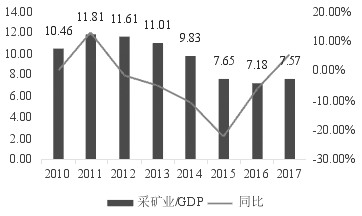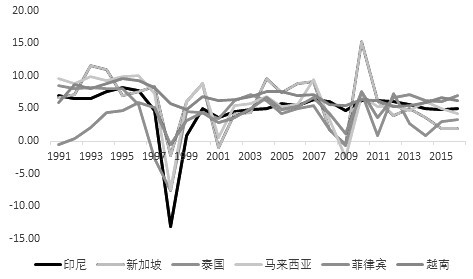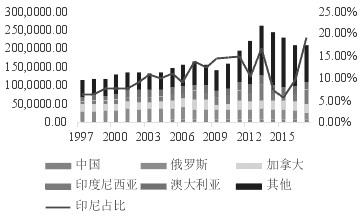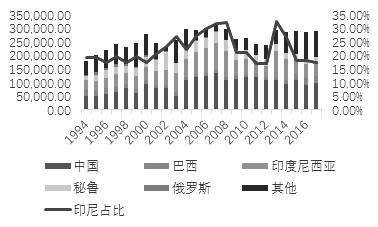A mining policy change
Indonesia is located in the Pacific Ocean 601099, the junction of the stock bar and the Indian Ocean, across the equator, with a land area of ​​1.919 million square kilometers and a marine area of ​​3.16 million square kilometers (excluding the special economic zone). It is composed of tens of thousands of islands and is the largest archipelago in the world. .
The resource-rich Indonesia and China are highly complementary in terms of economy. Indonesia can provide mineral resources such as oil, natural gas, copper, aluminum, nickel and tin that China needs. China's investment can also drive Indonesia's local economic development. Due to the rich mineral resources and low energy prices, many Chinese non-ferrous metals companies have invested in Indonesia.
The mining industry is an important industry in Indonesia. Before the comprehensive ban on raw ore mining policy in 2014, Indonesia's mining industry accounted for more than 10% of GDP. After 2014, the mining industry's share of GDP dropped significantly. In 2016, it fell back to 7.18%, 2017. After the government relaxed the export conditions of raw ore, the mining industry’s share of GDP rebounded to 7.57%.

The picture shows the mining industry is an important industry in Indonesia.
According to the new mineral law in 2009, the Indonesian government plans to ban the export of unprocessed metal ores and concentrates, hoping to encourage companies investing in mineral resources to establish smelting processing plants in Indonesia, limiting more mineral processing to Indonesia. To increase the added value of ore products and provide more jobs. On January 12, 2014, Indonesia announced the ban on the export of raw ore, which stipulated that unprocessed ore could not be exported. The prohibition on the export of raw ore has a greater impact on the export of bauxite and nickel ore, as Indonesia's bauxite production and nickel ore production accounted for 19% and 16% of global production in 2013 before the ore export ban took effect. .
However, due to the implementation of the ban, the Indonesian government lost a large amount of tax revenues and jobs, taking into account the equipment production capacity of the refinery, which is not enough to digest the local ore production, and the remaining ore is allowed to be sold overseas. Since January 12, 2017, India and West have relaxed export restrictions on some ore and semi-processed products, involving copper concentrates, laterite nickel ore, bauxite, anode mud and copper telluride. Mainly to cancel the export ban on nickel ore and bauxite, allowing the export of concentrates under certain conditions and extending the export ban on copper concentrates and other concentrates. The mines that are allowed to export need to meet two conditions. First, 30% of the smelting capacity must be used to process low-grade mines, and the rest can be used for export. Second, the smelting project must be completed within 5 years, and every 6 projects must pass through the Indonesian government. Monthly construction progress check, otherwise it will be disqualified.
At present, Indonesia's bauxite and nickel ore exports have gradually recovered. The data shows that in 2017, China imported a total of 1.29 million tons of Indonesian bauxite. With the increase of local export quotas, some traders gradually intervened, and market activity increased significantly. Indonesian bauxite is expected to gradually replace some of Malaysia's market share. According to SMM data, China imported a total of 3.81 million tons of Indonesian nickel ore in 2017, which is also a sharp rebound. In January 2018, Indonesia recently approved the export of nickel mines from TOSHIDA and INTERGRA. The quotas were 1.95 million and 1 million tons respectively, of which TOSHIDA had no records. As of January 2018, Indonesia has approved a total quota of 26.44 million tons of nickel ore exports, and it is expected that new quotas will be announced later.

The picture shows the GDP growth rate of Southeast Asian countries
B Distribution of mineral resources
As Indonesia's bauxite, nickel and tin mines account for a relatively high share of the global market, the following is a brief analysis of the current Indonesian non-ferrous metal mineral resources from the bauxite market, the nickel ore market and the tin market. Case.
Bauxite market
Yinxi is dominated by laterite-type bauxite, which has identified bauxite reserves of 1 billion tons, ranking sixth in the world, accounting for 3.57% of the world's total reserves. It is mainly distributed in the western part of Kalimantan Island, Bangka Island, and Ridong Island and Riau provinces. The West Kalimantan bauxite metallogenic belt is one of the most important producing areas of bauxite in Southeast Asia. The scale of the deposit is large, the ore quality is good, and the Al2O3 content is 45%-55%. The Al2O3 content of Bunga Island bauxite mine is 38.6%-43%, the resource endowment is better, and the degree of exploration and development is lower.
Although Indonesia's bauxite production accounted for 19% of the world's total bauxite production before the ban on raw ore exports, it was once the world's largest bauxite exporter, but its reserves accounted for only 3.57% of global reserves. It is much higher than reserves. If it continues, Indonesia will face the problem of depletion of bauxite resources. Therefore, the Indonesian government hopes to encourage enterprises to carry out smelting and processing in the local area by changing the way of exporting resources. On the one hand, it will increase the added value of products, and on the other hand, it will promote employment and economic growth.

The picture shows the proportion of global bauxite production in Indonesia
Although Indonesia's ban on bauxite exports once triggered a panic in the aluminum supply shortage in the aluminum market, due to the sufficient inventory of Chinese companies before the ban on exports, Malaysia's bauxite supplements and domestic large aluminum companies actively accounted for the proportion of resource reserves. Up to 26.43% of the distribution of bauxite production projects in Guinea, Indonesia's ban on bauxite exports did not have much impact on China's bauxite import supply.
Nickel market
Indonesia has identified nickel ore reserves of 4.5 million tons, ranking seventh in the world, accounting for 5.77% of global reserves, mainly in the eastern part of the archipelago, from Sulawesi to Halmahra, Obi, Waig The Islands, and the Tanamela region of the Bird's Head Peninsula in Irian Jaya (West Papua).
The production and reserves of nickel ore still face the same problems as bauxite, and the proportion of production greatly exceeds the proportion of reserves. However, at present, the supply is still very sufficient, which is the supply growth point of nickel ore. From the perspective of encouraging mining companies to build smelting and processing plants locally, the Indonesian government has proposed to review enterprises that have nickel ore export quotas, and fines those enterprises that have indicators but no smelting capacity (including under construction). Even cancel its export quota. The news once triggered concerns about the accelerated export of Indonesian nickel ore, which put pressure on nickel prices.

The picture shows the proportion of global nickel ore production in Indonesia
According to SMM data, among the 20.49 million tons of export quotas approved by the Indonesian government, only 2.3 million tons of PT Cetia Nugraha Indotama mines have no smelting capacity under construction, and there is a risk that they cannot pass the government review. high. Moreover, the requirements for this review are relatively low, and 10% of the progress can be met, so the short-term impact is not large, but it is expected that Indonesia's nickel ore exports will increase significantly in 2018.
Tin mine market
Indonesia has a reserve of 800,000 tons of tin mines, ranking second in the world, accounting for 17.02% of global reserves. It is mainly distributed in the Riau Islands off the east coast of Sumatra, especially Bangka Island, Belitung Island, and the east coast of Sumatra. In the vicinity, it is the same as the tin ore belt of the Minxi tin mine in China and Myanmar, Thailand and Malaysia. The ore belt is more than 2,500 kilometers long, and the tin belt in Indonesia is about 750 kilometers long.

The picture shows the proportion of Indonesia's tin production in the world
Since 2014, tin mines have been banned from exporting in Indonesia. Indonesia, which has the second largest tin mine reserves, is also facing the problem of rising mining costs due to over-exploitation. Take PTTimah, Indonesia's largest tin producer, for example. Tianma's tin mine production accounts for nearly 40% of Indonesia's national production. The data shows that the company's tin concentrate production has shown two major trends in recent years. First, the total output continued to decline, from a systematic reduction of 38,000 tons in 2010 to 24,000 tons in 2016; the second is accompanied by the depletion of resources on land mines. Sea mines account for the main output and mining costs are forced to rise.
As the world's major tin mining areas are facing the same decline in grades and production declines, whether the tin mines in Indonesia can be supplemented after the sharp decline in the tin mines in Myanmar will be one of the focus of the market.
C Development of the non-ferrous smelting and processing industry
Due to changes in the Indonesian government's mining policy, it is hoped that through the use of mineral resources to attract investment, encourage enterprises to carry out smelting and processing in the local area, increase product added value and promote employment and economic growth, the development of its non-ferrous smelting and processing industry is very worthy of attention.
Aluminum industry chain
In terms of alumina construction, China Hongqiao, Nanshan Aluminum Industry 600219, China Bar, China Aluminum 601600, China Bar and Jinjiang Group and other large domestic aluminum companies have alumina plants in Indonesia. China Hongqiao plans to invest in the construction of an annual output of 4 million tons of alumina project, the current phase of 1 million tons of alumina project has been completed and put into production. China Hongqiao plans to build a second alumina plant with a capacity of 1 million tons in Indonesia by the end of 2018. Nanshan Aluminum plans to invest 1 million tons of alumina project in Tannanshan Industrial Park in Bintan Island, Riau Province, Indonesia. The project construction period is expected to be 3 years and the production period is 23 years. It is hoped to utilize the abundant bauxite and coal resources. Utilize the low cost advantage to expand alumina production capacity, improve the profitability of alumina and the raw material reserve capacity of enterprises.
In addition, Indonesia's Sanmas Mocha Company's first phase of 1 million tons of alumina project started in October 2017, with a planned annual production capacity of 2 million tons, and Nanshan Aluminum Industry accounted for 30% of the investment. In addition, Chinalco and Jinjiang Group also have alumina projects in Indonesia.
In terms of electrolytic aluminum production, Indonesia's self-produced electrolytic aluminum is still insufficient to meet its own needs and still needs to be imported. Indonesia's Asahan Aluminum Co., Ltd. is the only aluminum producer in Indonesia. Its current production capacity can only meet one-third of the domestic aluminum demand. Indonesia's annual aluminum demand is about 800,000 tons. The company's development goal is to double the production of electrolytic aluminum by 2020, reaching 500,000 tons/year, and reaching 1 million tons/year in 2025. China Hongqiao is considering transferring production capacity of electrolytic aluminum that was discontinued due to supply-side reforms to Indonesia, as Indonesia has already deployed an upstream alumina production plant.
Nickel industry chain
In the production of ferronickel and stainless steel, the rapid development of Indonesian ferronickel and stainless steel production capacity has also changed the situation of the entire industrial chain. It is expected that with the commencement of production of low-cost ferronickel enterprises in Indonesia, China's ferronickel capacity will gradually be squeezed out. The overall situation is that Indonesia's ferronickel capacity is increasing and China's ferronickel capacity is decreasing.
Specific to the enterprise, the fastest growing in the nickel-iron stainless steel industry is the Castle Peak Group. Qingshan Industrial Park is the foreign-invested mining project with the fastest capital, the fastest construction and the most fruitful results after Indonesia issued the prohibition. The park covers an area of ​​more than 1,300 hectares. It is mainly equipped with a thermal power plant with a total capacity of more than 1000 megawatts, a 100,000-ton wharf, a simple airport and a living area with a total construction area of ​​about 200,000 square meters. The total investment amount is 50. One hundred million U.S. dollars.
Since the establishment of the park in July 2013, Qingshan Holdings has started production of three projects in less than four years, and achieved production within four months of production. It achieved stable and overproduction within one year, and the output exceeded the original design output and operated stably. The Indonesian Qingshan stainless steel ferronickel project began to electrify and complete the complete industrial chain of Indonesia's “nickel mine – ferronickel – stainless steelâ€.
Tin industry chain
PTTimah is the largest tin mining operator in Bangka, Indonesia's tin-concentration area, and the largest comprehensive tin mining company in the world. Since tin mines are banned from exporting in Indonesia, the main impact on the global market is the export of finished tin. Since July 2013, Indonesia’s import and export rules have changed to increase the export volume of high value-added tin products. The minimum purity requirement for tin ingot exports has been raised from the previous 99.85% to 99.9%, which has increased the production costs of enterprises and reduced the production enthusiasm of enterprises. The export of refined tin has dropped from about 100,000 tons in 2012 to less than 70,000 tons in 2016, and it has risen to over 70,000 tons in 2017. The number of finished tin indicators exported by PTTimah to foreign markets in 2017 reached 30,000 tons, a year-on-year increase.
In summary, Indonesia is a country rich in mineral resources, and its policy of attracting investment to develop middle and lower reaches industries to drive local economic development is being implemented.
(Editor: Wu Xiaolin HF106)
Warm Men'S Pant,Fashion Pant,Fashion Dyed Pant,Garment Dyed Pants
SHAOXING NEWGROUND TEXTILE TRADING CO., LIMITED , https://www.shaoxingnewground.com
